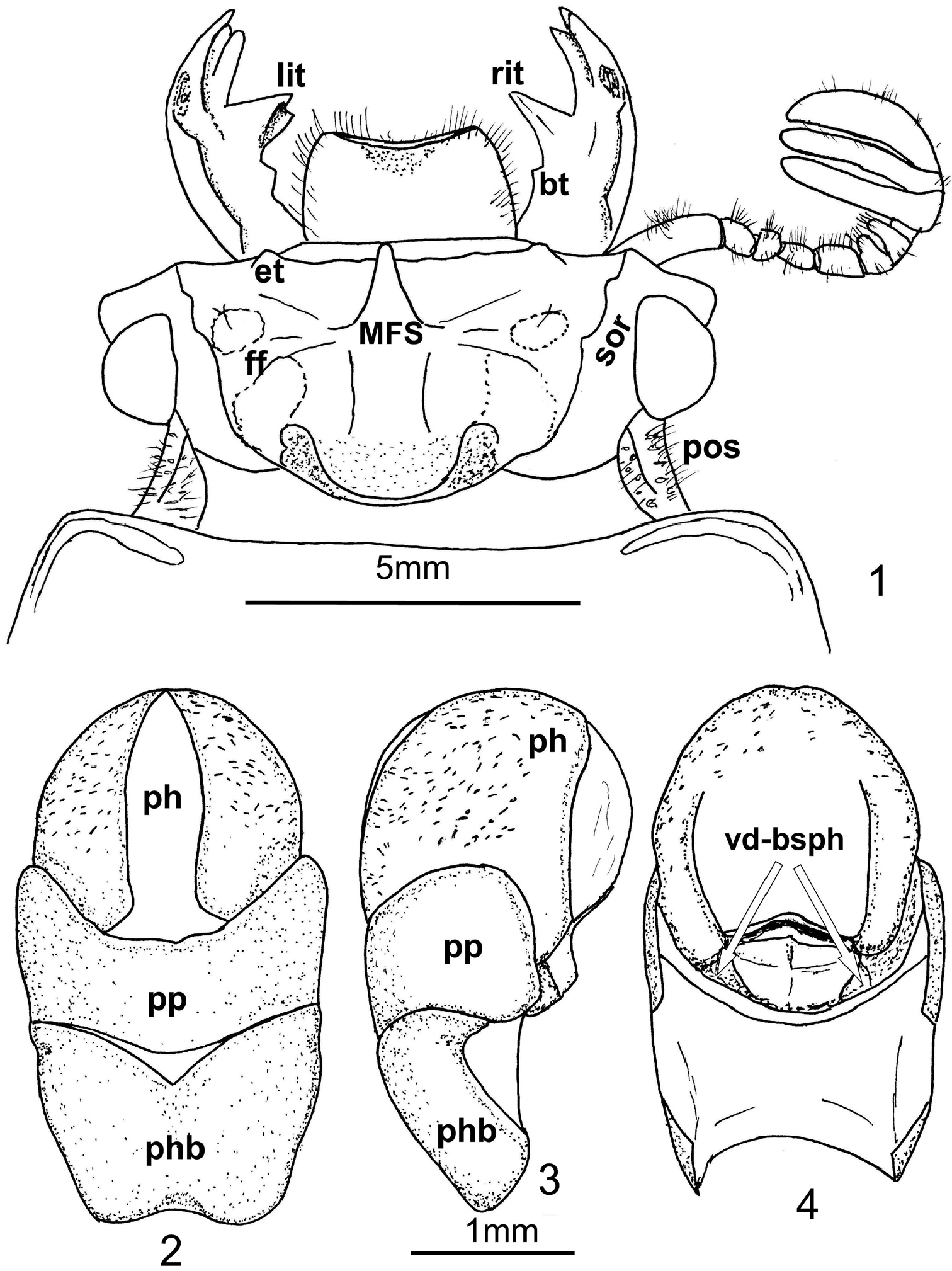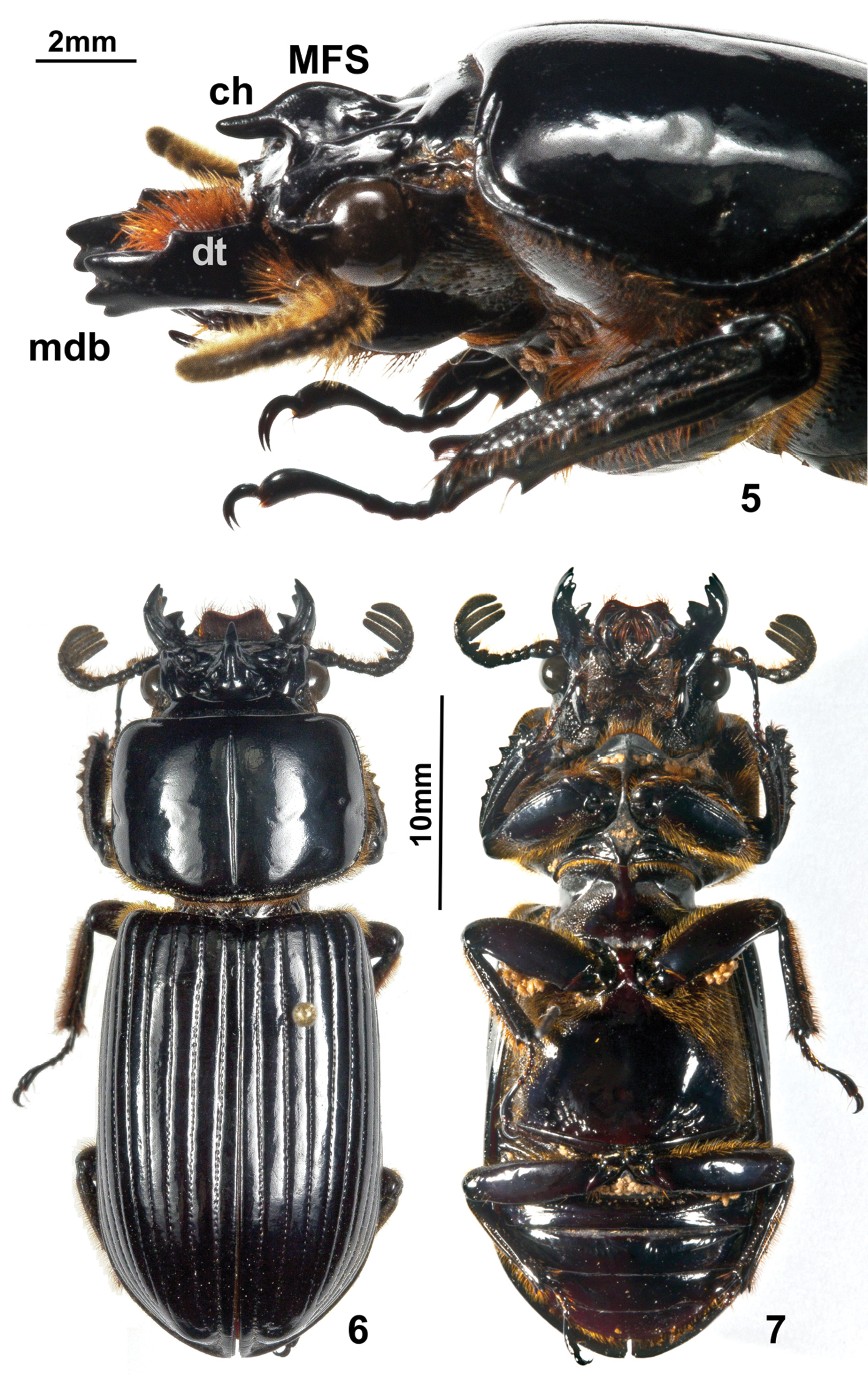






(C) 2012 Enio B. Cano. This is an open access article distributed under the terms of the Creative Commons Attribution License 3.0 (CC-BY), which permits unrestricted use, distribution, and reproduction in any medium, provided the original author and source are credited.
For reference, use of the paginated PDF or printed version of this article is recommended.
Oileus gasparilomi sp. n. is described from nine specimens from the mountains of Quiché in Guatemala, from cloud forest at 1795 m elevation. This represents the second species of the genus for Guatemala, differing from the closely related Mexican species Oileus rimator (Truqui) in having a straight anterior clypeal border, the postocular sulcus divided by a keel and the pronotum almost straight (not clearly bilobed). A key to the species of Oileus is given.
Resumen
Se describe Oileus gasparilomi sp. n. de un bosque nuboso a 1795 m, de las montañas de Quiché en Guatemala. Esta es la segunda especie del género conocida para Guatemala y se separa de la especie mexicana más relacionada, Oileus rimator (Truqui), porque posee el borde anterior del clípeo recto, el surco postocular dividido por una quilla y el pronoto casi recto (no claramente bilobado). Se provee una clave para las especies Oileus.
Passalidae, Oileus, Guatemala, Quiché, cloud forest
The genus Oileus Kaup consists of five species (
For terminology we follow
The genus was revised by
urn:lsid:zoobank.org:act:7998265B-1510-4F1E-9CFB-58974C869BB7
http://species-id.net/wiki/Oileus_gasparilomi
Figures 1– 7Nine specimens.
Holotype male, pinned: GUATEMALA: Quiché Dept., Municipio de Chajul, aldea Chel, camino a Cabá, 15°38'57.10"N, 91°01'10.25"W (DMS), 1795m, bosque nuboso, VI 2008. Col. A. González-Madrid (UVGC).
Paratypes. five males and three females, same data as holotype, pinned (UVGC, USAC, IEXA and IBUNAM).
Oileus gasparilomi is a macropterous species, closely related to the Oileus rimator complex of species. The clypeus with anterior border straight, the postocular sulcus divided by a keel and the pronotum not clearly bilobed (almost straight) separates the new species from Oileus rimator. Ventrodorsal basal sclerotizations of the phallus (autapomorphy of the genus Oileus according to
Description. Head. Anterior border of labrum concave, dorsal surface granular. Clypeus inclined, anterior border straight, posterior border crenulate. Frontoclypeal suture slightly concave at center, external tubercles rounded. Frontal area inclined, smooth and shiny in front of Median Frontal Structure (MFS); frontal ridges feebly developed, inner tubercles absent. Frontal fossae glabrous and smooth, composed of three separated small fossae: the anterior separated from the slightly bigger medial one by a keel than runs laterally from the MFS, and this separated from the posterior by an incomplete keel. MFS of “striatopunctatus” type (see
Thorax. Anterior border of pronotum not clearly emarginate medially, almost straight. Lateral fossae of pronotum without coarse punctations. Pronotum with marginal groove narrow and smooth; anterior angles rounded. Pronotum with sparse, small and shallow punctations, moderately visible at low magnification. Mesosternum with lateral depression elongate, with elongate punctations, setose, with external border opaque. Mesepisternum with large opaque area. Metasternum laterally with dense setiferous punctations; disk shiny, delimited by 16–19 (up to 34) rugose punctations; marginal fossa setose, with coarse elongate punctations posterior part 1.5–2 times wider than the median part.
Elytra. Striae marked with defined punctations; striae 1–4 less well marked than 9–10, interstriae 1–5 with scarce micropunctations, more abundant and visible at lower magnification on interstriae 6–10. Anterior border of elytra vertical (Figure 4); humerus with tuft of setae on interstriae 5–10.
Wings. Well developed.
Legs. Profemur with anterior-ventral groove well marked, reaching the punctate setose apical area. Mesotibia with one (or two, if a spiniform keel is present) spine(s).
Abdomen. Marginal groove incomplete, occupies 3/5 of last sternite.
Aedeagus (Figures 2–4). In ventral view, phallus spherical; parameres and phallobase not fused; parameres without a longitudinal division. In dorsal view (Figure 4), ventrodorsal basal sclerotizations of the phallus present.
Dimensions (mm) (n = 9): total length 35.75-41.80, (µ = 38.26); elytral length 20.30–22.40, (µ = 21.35); pronotal length 8.4–9.6, (µ = 9.14); pronotal width 10.7–12.0, (µ = 11.74); humeral width 11.65-12.65, (µ = 12.07).
Larva. Unknown.
Oileus gasparilomi sp. n., holotype 1 head lit left internal teeth of mandible rit right internal teeth of mandible bt basal tubercle of mandible et external tubercle MFS Median Frontal Structure sor supraorbital ridge ff frontal fossae pos postocular sulcus 2–4 aedeagus 2 ventral view 3 lateral view 4 dorsal view ph phallus pp parameres phb phallobase vd-bsph ventrodorsal basal sclerotizations of phallus
Oileus gasparilomi sp. n., paratype (USAC) 5 lateral view of head and pronotum MFS Median Frontal Structure ch center horn mdb mandible dt dorsal tooth of mandible 6 habitus in dorsal view 7 habitus in ventral view
Named after Gaspar Ilóm, a native hero of the novel “Men of Maize” by Miguel Ángel Asturias. The collection locality is called “mountains of Ilóm”.
The species is known only from mid-altitude cloud forest from the type locality, near Chel Village, road to Cabá in Chajul, Quiché, Guatemala. The southernmost locality of the closest relative, Oileus rimator, is in the northern mountains of Chiapas, Finca La Trinidad, at Municipio El Bosque (
Key to the adults of known species of Oileus
| 1 | Lateral margin of mesosternum with abundant setae | 2 |
| – | Lateral margin of mesosternum glabrous | 3 |
| 2 | Anterior border of clypeus widely notched at center | Oileus rimator (Truqui) |
| – | Anterior border of clypeus straight | Oileus gasparilomi Cano & Schuster, sp. n. |
| 3 | Eyes reduced, kidney-shaped, at least half covered by ocular canthus; elytra oval; body length 34–48mm; Mexico | 4 |
| – | Eyes normal, globose, less than half covered by ocular canthus; elytra rectangular; body length 28–33mm; Chiapas (Mexico) to Colombia | Oileus sargi (Kaup) |
| 4 | Elytral striae indistinct or with feebly visible punctations; cephalic horn with dorsal longitudinal groove, extending more than one half the length of the horn; ocular canthus acute-angled | 5 |
| – | Elytral striae marked with more or less developed but always distinct punctuations; cephalic horn with dorsal longitudinal groove extending one third the length of the horn or less, or absent; ocular canthus with rounded apex, greater than 90 degrees; Oaxaca | Oileus bifidus (Zang) |
| 5 | Frontoclypeal suture slightly concave at center; dorsal surface of mandibles smooth; all elytral striae barely marked; body length 44–47mm; Sierra Madre Oriental | Oileus heros (Truqui) |
| – | Frontoclypeal suture straight; dorsal surface of mandibles with small punctations; elytral striae 1–2 poorly marked, 3–6 indistinct at least in anterior and posterior third; body length 42–44mm; Sierra Madre Oriental | Oileus nonstriatus (Dibb) |
We thank J.J. Morrone (Facultad de Ciencias, UNAM) and Santiago Zaragoza (Instituto de Biología, UNAM) for comments on the manuscript. We thank Alejandro González-Madrid for collecting and donating the specimens. E.B. Cano was supported by the Programa de Posgrado en Ciencias Biológicas of Universidad Nacional Autónoma de México (UNAM), Escuela de Biología of Universidad de San Carlos de Guatemala and Universidad del Valle de Guatemala.

